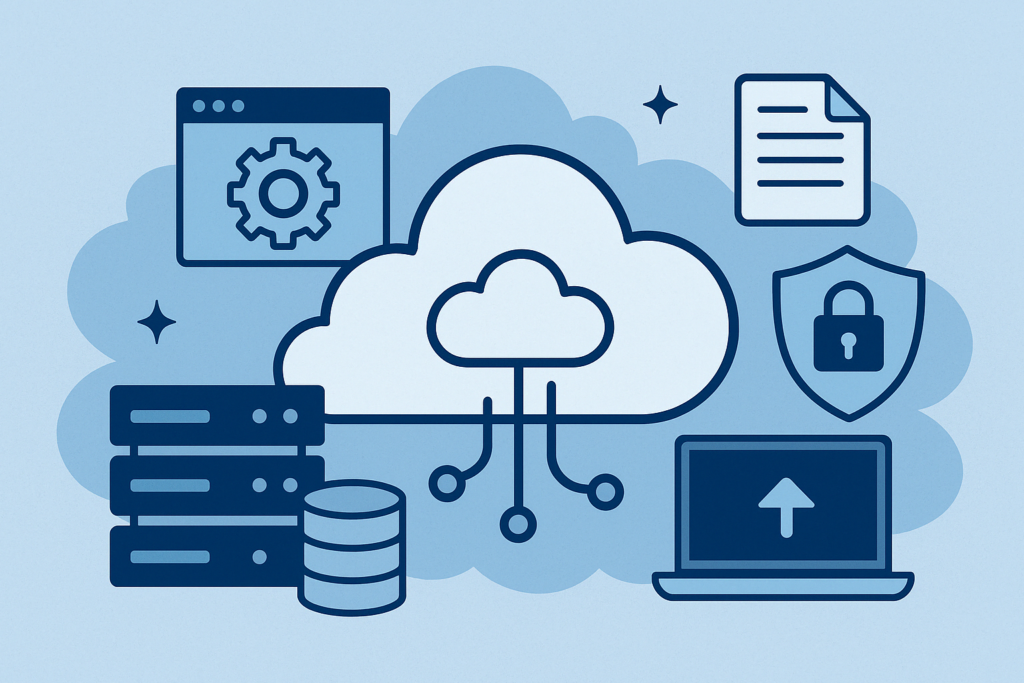In the age of digital disruption, businesses are constantly looking for ways to innovate faster, reduce operational costs, and remain competitive. Cloud technology has emerged as the cornerstone of this transformation. Once viewed with skepticism, it is now recognized as a reliable, secure, and scalable solution that powers everything from startups to Fortune 500 companies. In this article, we explore why cloud technology is the future of scalable and secure computing — and why your organization should invest in it today.

Understanding Cloud Technology
At its essence, cloud computing refers to the delivery of computing services — including servers, storage, databases, networking, software, analytics, and intelligence — over the internet (“the cloud”) to offer faster innovation, flexible resources, and economies of scale.
There are three primary cloud service models:
- Infrastructure as a Service (IaaS) – Provides virtualized computing resources over the internet. Example: AWS EC2, Azure Virtual Machines.
- Platform as a Service (PaaS) – Offers hardware and software tools over the internet, primarily for application development. Example: Google App Engine, Heroku.
- Software as a Service (SaaS) – Delivers software applications via the cloud, eliminating the need for local installation. Example: Microsoft 365, Salesforce.
Unmatched Scalability
Traditional IT infrastructure often requires heavy upfront investments and forecasting of hardware needs. With cloud technology, scalability becomes one of the biggest advantages.
1. Elastic Resource Allocation
Cloud services automatically allocate more resources during peak demand and scale them down when not needed. This elasticity ensures consistent performance without wasting resources or spending unnecessarily.
2. Pay-as-You-Go Model
With cloud platforms, businesses only pay for the resources they consume. This is especially beneficial for startups and SMEs who cannot afford to invest in costly data centers or hardware.
3. Global Reach
Cloud services allow applications to be deployed across data centers worldwide. This enables businesses to serve customers in multiple geographies with low latency and better reliability.

Security at the Core
One of the early concerns around cloud adoption was data security. However, major cloud providers have turned this around by offering enterprise-grade security solutions that are often more advanced than on-premise setups.
1. Data Encryption
Cloud platforms encrypt data at rest and in transit using advanced encryption standards (AES-256, TLS 1.2+). This ensures that even if data is intercepted, it remains unreadable to unauthorized users.
2. Access Control and IAM
Identity and Access Management (IAM) tools provide granular control over who can access what resources. Features like multi-factor authentication (MFA), role-based access control (RBAC), and single sign-on (SSO) enhance the overall security posture.
3. Compliance and Certifications
Top cloud providers are compliant with global standards like:
- ISO/IEC 27001
- SOC 1, SOC 2, and SOC 3
- HIPAA (for healthcare)
- GDPR (for EU data privacy)
This makes it easier for companies to meet industry-specific regulatory requirements.
4. Built-in Security Tools
From AI-powered threat detection to DDoS protection and automated security patching, cloud platforms integrate security into every layer of the technology stack.
Fostering Innovation and Agility
Cloud technology is not just a cost-saving measure — it’s a driver of innovation. Here’s how:
1. Faster Development Cycles
Cloud platforms support DevOps practices with integrated CI/CD pipelines, automated testing, and containerization tools like Docker and Kubernetes. Developers can release updates more frequently and with greater confidence.
2. Serverless Architecture
Serverless computing allows developers to focus purely on writing code without worrying about the underlying infrastructure. Services like AWS Lambda, Azure Functions, and Google Cloud Functions help teams build lightweight, scalable applications effortlessly.
3. Advanced Technologies at Your Fingertips
Cloud platforms give easy access to cutting-edge technologies like:
- AI and Machine Learning
- Big Data Analytics
- IoT (Internet of Things)
- Blockchain-as-a-Service
Without the cloud, accessing and deploying these technologies would require extensive hardware and expertise.
Disaster Recovery and Business Continuity
Unforeseen events — from cyber-attacks to natural disasters — can disrupt business operations. The cloud offers robust disaster recovery solutions:
- Automated Backups
- Geo-redundancy
- High Availability (HA) Architectures
- Disaster Recovery as a Service (DRaaS)
These features help businesses restore operations quickly, ensuring continuity and minimizing losses.
Use Cases Across Industries
Healthcare
Cloud solutions enable real-time access to patient data, secure health records, and telemedicine platforms. HIPAA-compliant cloud services also support AI-driven diagnostics and remote monitoring tools.
Finance
Banks and fintech companies rely on cloud platforms for fraud detection, mobile banking, and real-time transaction processing — all while complying with regulations like PCI-DSS and SOX.
Retail
Retailers use cloud services for e-commerce platforms, customer behavior analytics, and omnichannel experiences. During high-traffic periods like Black Friday, auto-scaling ensures uptime and performance.
Education
Cloud technology supports virtual classrooms, collaborative learning platforms, and scalable LMS (Learning Management Systems), revolutionizing the way education is delivered and consumed.
The Rise of Hybrid and Multi-Cloud Strategies
Businesses are increasingly adopting hybrid cloud (a mix of on-premise and cloud) and multi-cloud (using services from multiple cloud vendors) strategies. This provides:
- Flexibility to deploy workloads where they perform best.
- Reduced Vendor Lock-in by avoiding over-reliance on a single provider.
- Enhanced Reliability with redundancy across platforms.
Challenges and Considerations
Despite its benefits, cloud adoption comes with a few challenges:
- Data Migration Complexity: Moving legacy systems to the cloud can be complex and time-consuming.
- Cost Management: Without proper monitoring, cloud spending can spiral out of control.
- Skill Gaps: Organizations need skilled professionals to manage and optimize cloud environments.
However, these challenges are often outweighed by the long-term benefits, and can be addressed with proper planning and the right cloud strategy.
The Road Ahead
As technology continues to evolve, so does cloud computing. Emerging trends include:
- Edge Computing: Bringing computation closer to data sources for low-latency processing.
- AI-as-a-Service: Making powerful AI tools accessible to all businesses.
- Sustainable Cloud: Eco-friendly data centers with a focus on reducing carbon footprints.
- Quantum Computing in the Cloud: Though still early-stage, this will revolutionize problem-solving in science, cryptography, and optimization.
Conclusion: Cloud is the Foundation of Digital Transformation
Cloud technology has transformed from an IT option to an operational necessity. It offers the scalability to grow, the security to protect, and the agility to adapt — everything a modern organization needs to thrive in a digital-first world.
Whether you’re just starting your cloud journey or looking to optimize an existing cloud infrastructure, investing in cloud technology today means preparing your business for tomorrow.
The future of computing isn’t just in the cloud — it is the cloud.


